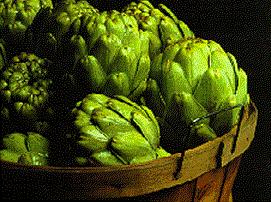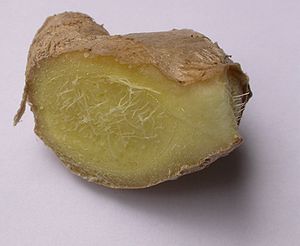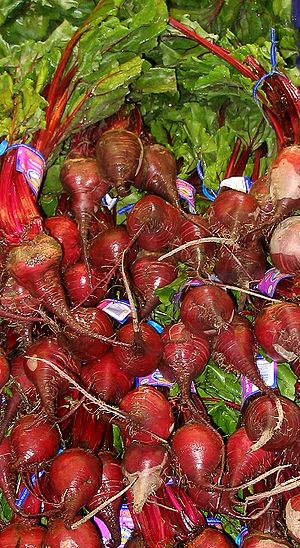 Image via Wikipedia
Image via WikipediaTo be completely honest when I first saw the artichoke as a small child it scared me, I thought it was one of the pods from invasion of the body snatchers. So it took a long time for me to look at an artichoke and not run from it, then one day a friend served me some and the look I gave her was are you freaking kidding me I am not going to eat this thing. I don't know if I can, she said go ahead at least try it once. So I did and I must confess it was delicious and I feel so silly now thinking it was a pod that would eat me (lol) Well here is a brief history of this vegetable.
The Globe Artichoke (Cynara cardunculus)is a perennial thistle originating in Southern Europe around the Mediterranean. It grows to 1.4 metres (4.6 ft) to 2 metres (6.6 ft) tall, with arching, deeply lobed, silvery glaucous-green leaves 50 centimetres (20 in) - 82 centimetres (32 in) long. The flowers develop in a large head from an edible bud about 8 centimetres (3.1 in) to 15 centimetres (5.9 in) diameter with numerous triangular scales; the individual florets are purple. The edible portion of the buds consists primarily of the fleshy lower portions of the involucral bracts and the base, known as the "heart"; the mass of immature florets in the center of the bud is called the "choke" or beard. These are inedible in older larger flowers.
The origin of artichokes is unknown, though they are said to have come from the Maghreb (North Africa), where they are still found in the wild state; the seeds of artichokes, probably cultivated, were found during the excavation of Mons Claudianus in Egypt during the Roman period. The various names of the artichoke in European languages all ultimately come from Arabic al-kharshuf (approximate spelling).The Arabic term Ardi-Shoki (ارضي شوكي) which means "ground thorny" is a folk etymology of the English name.
The cardoon, a naturally occurring variant of the same species, is native to the South Mediterranean, even though it has not been mentioned in extant Classic literature. Artichokes were cultivated in Sicily during the Greek occupation, the Greeks calling them kaktos. In this period the leaves and flower heads, which cultivation had already improved from the wild form, were eaten. The Romans, who called the vegetable carduus received the plant from the Greeks. Further improvement in the cultivated form appear to have taken place in the Muslim period in the Maghreb, although the evidence is inferential only.
An artichoke flower.
Globe artichokes are known to have been cultivated at Naples around the middle of the 9th century. Modern scholar, Le Roy Ladurie, in his book Les Paysans de Languedoc has documented the spread of the artichoke:
"The blossom of the thistle, improved by the Arabs, passed from Naples to Florence in 1466, carried by Filippo Strozzi. Towards 1480 it is noticed in Venice, as a curiosity. But very soon veers towards the north-west...Artichoke beds are mentioned in Avignon by the notaries from 1532 onward; from the principle towns they spread into the hinterlands...appearing as carchofas at Cavaillon in 1541, at Chateauneuf du Pape in 1553, at Orange in 1554. The local name remains carchofas, from the Italian carciofo...They are very small, the size of a hen's egg...and are still considered a luxury, a vaguely aphrodisiac tidbit which one preserved in sugar syrup."
In the US, large globe artichokes are most frequently prepared for cooking by removing all but 5 millimeters (0.20 in) to 10 millimeters (0.39 in) or so of the stem, and (optionally) cutting away about a quarter of each scale with scissors. This removes the thorns on some varieties that can interfere with handling the leaves when eating. Then, the artichoke is boiled or steamed until tender. If boiling, salt can be added to the water, if desired. It may be preferable not to cover the pot while the artichokes are boiled, so that the acids will boil out into the air.
Globe Artichoke buds ready for cooking
Covered, and particularly cut artichokes can turn brown due to the acids and chlorophyll oxidation. If not cooked immediately, placing them in water lightly acidulated with vinegar or lemon juice prevents the discoloration. Leaves are often removed one at a time and the fleshy base part eaten, sometimes dipped in hollandaise, vinegar, butter, mayonnaise, aioli, lemon juice or other sauces, the fibrous upper part of each leaf being discarded; the heart is then eaten when the inedible choke has been discarded after being carefully peeled away from the base. The thin leaves covering the choke are mostly edible.
In Italy, artichoke hearts in oil are the usual vegetable for spring in the 'Four Seasons' pizza (with olives for summer, mushrooms for autumn and prosciutto for winter).In Spain, the more tender younger and smaller artichokes are used. They can be sprinkled with olive oil and left in hot ashes in a barbecue, sauteed in olive oil with garlic, with rice as a paella or sauteed and combined with eggs in a tortilla (frittata). More often cited are the Greek artichokes (à la polita), of which probably the finest examples are to be found on the island of Tinos and in Iria and Kantia,two small villages,in Argolida in the peloponnese of southern Greece.
Often thrown away, the cores of artichoke stems, once the fibrous exterior has been discarded, are perfectly edible and taste like the artichoke heart.
How to clean Whole Artichokes
1.Cut off the bottom of the stem, leaving about 1/2 inch.
2.Pull off any small fibrous dark leaves around the base.
3.Cut off the top 1/2 inch of the artichoke.
4.Using scissors, trim off the sharp, pointed tips of the remaining leaves.
How to clean Baby Artichokes
1.Snap off the dark-green outer leaves of the artichoke until only the pale, tender inner leaves remain.
2.Cut off the top 1/4 inch of the artichoke.
3.Trim the stem end and any dark parts around the bottom.
4.Rub the reserved lemon half over all the cut ends, this helps them from browning.
Keep Your Artichokes Looking Fresh
Artichokes are especially prone to oxidation, and that’s why we recommend immediately rubbing their cut surfaces with extra lemon juice before submerging them in acidulated water.
Artichokes are nutrient dense and contain 16 essential nutrients and only 25 calories in a medium one. They are rich in manganese, which enhances thyroid function. Manganese helps the thyroid gland convert inactive thyroxine into active triiodothyronine, which boosts your metabolism and your mood.
They are also a very good source of vitamins A and C, folic acid, biotin, niacin, riboflavin,
thiamine, potassium, the trace mineral manganese, and a carbohydrate that is in the form of insulin.
Please be advised Anyone with gallbladder disease should take artichoke only under supervision of a doctor.
From Wikipedia
The information in the article should not be considered as medical advice,The information in the article this diclaimer is not meant to treat, diagnose, prescribe or cure any ailment. Always check with your physician before taking any products or following any advice you have read on BBW Beauties
 Image via WikipediaI guess the old saying of an apple a day keeps the doctor away, to my surprise I just found out how beneficial it is to eat apples. Apples contain a number of antioxidant such as polyphenol and flavonoid that reduce the risk of development of cancer by preventing DNA damage.
Image via WikipediaI guess the old saying of an apple a day keeps the doctor away, to my surprise I just found out how beneficial it is to eat apples. Apples contain a number of antioxidant such as polyphenol and flavonoid that reduce the risk of development of cancer by preventing DNA damage.


























